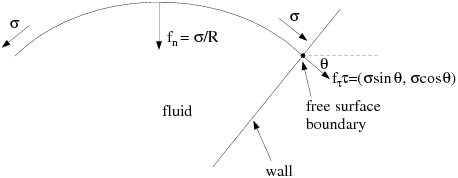Surface (or interfacial) tension plays an important role in free-surface and moving-interface problems. This section describes the phenomena associated with surface tension, and the equations used to model it in Ansys Polyflow.
Consider a curved surface located on the boundary, as shown in Figure 15.2: Surface Tension on a Free Surface, and let
be the outward normal from the surface.
The surface tension force is a force of amplitude , acting tangent to the surface, whose net
influence (through the vector sum on an elementary surface) is in the
normal direction. This normal force (per unit area or
length)
tends to reduce the surface curvature. The parameter
is called the surface tension coefficient, and satisfies the
following equation:
(15–17) |
is the Gaussian curvature of the surface:
(15–18) |
where and
are the two principal radii of curvature (measured in
orthogonal directions). For 2D axisymmetric domains, the surface curvature
introduced by the symmetry about the
axis must also be taken into account at the outlet, so that
never becomes zero in an axisymmetric geometry when
is nonzero.
In particular, even in the absence of applied external forces, a free jet is subject to a normal surface force given by Equation 15–17 and Equation 15–18.
In Ansys Polyflow, surface tension forces are introduced on the right-hand side of the momentum equations when a nonzero surface tension coefficient is specified. Introduction of Equation 15–17 in a finite-element code requires integration by parts (in 2D) or use of Green's theorem for Riemann's surfaces (in 3D) in order to use only first-order derivatives of the shape functions that characterize the geometry of the surface.
In 2D, integrating by parts the product of Equation 15–17 and the
velocity shape functions introduces tangential forces at both ends of the free
surface. These forces describe the reaction that the "external world" exerts on
the free surface in order to equilibrate the tensile force .
It can be shown that, in order to maintain the equilibrium with the tensile
force on the free surface, this tangential force must be defined as
(15–19) |
where is the unit vector tangent to the free surface and directed
away from the surface (because the surface is in tension, not in compression).
An angle () is used to describe the direction of
:
(15–20) |
Positive angles are measured counterclockwise with respect to a horizontal
reference axis. In Figure 15.3: Surface Tension and Traction at the Extremities of a Free Surface, is a negative angle (for example, –30°). This
angle allows Ansys Polyflow to account for the reaction of the external world on
the boundary of the free surface.
Surface tension can be modeled in 3D, but only if normal velocity condition
has been imposed on the boundaries adjacent to the free surface, so that there
is no need to define boundary conditions specific to the 3D surface tension
model. Also, the angle cannot be specified for 3D problems.
An additional difficulty occurs when the flow velocity is prescribed at one edge of a free surface that includes surface tension, because the force term that describes the angle condition is overwritten by the velocity condition. If the position of the free surface at this point is known, it is necessary to suppress all possible free-surface displacements. If the position is unknown, a moving-contact-point problem is posed (see Static and Dynamic Contact Points or Lines). Also free-surface positions should be prescribed only where the velocity is also prescribed.




